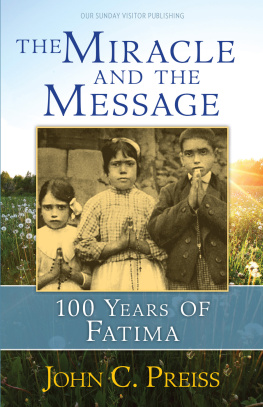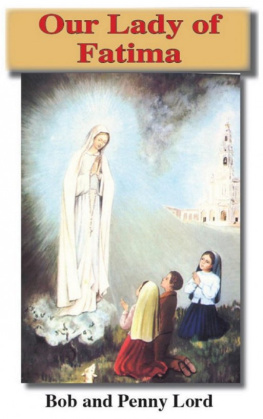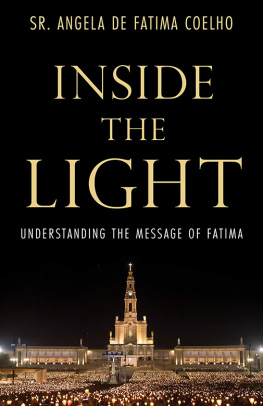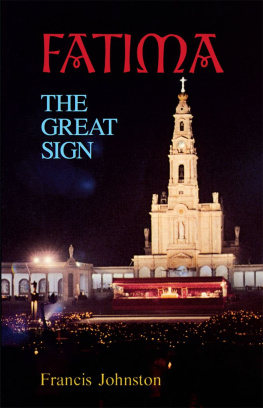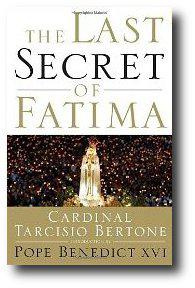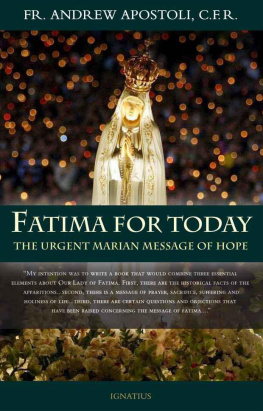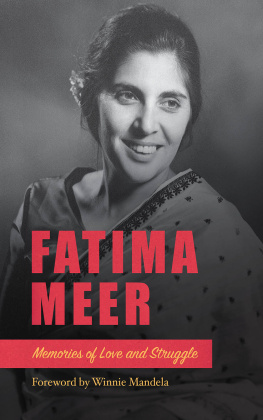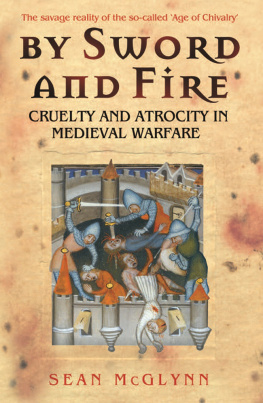Fr. Thomas McGlynn - Vision of Fatima
Here you can read online Fr. Thomas McGlynn - Vision of Fatima full text of the book (entire story) in english for free. Download pdf and epub, get meaning, cover and reviews about this ebook. year: 2017, publisher: Sophia Institute Press, genre: Detective and thriller. Description of the work, (preface) as well as reviews are available. Best literature library LitArk.com created for fans of good reading and offers a wide selection of genres:
Romance novel
Science fiction
Adventure
Detective
Science
History
Home and family
Prose
Art
Politics
Computer
Non-fiction
Religion
Business
Children
Humor
Choose a favorite category and find really read worthwhile books. Enjoy immersion in the world of imagination, feel the emotions of the characters or learn something new for yourself, make an fascinating discovery.
- Book:Vision of Fatima
- Author:
- Publisher:Sophia Institute Press
- Genre:
- Year:2017
- Rating:5 / 5
- Favourites:Add to favourites
- Your mark:
- 100
- 1
- 2
- 3
- 4
- 5
Vision of Fatima: summary, description and annotation
We offer to read an annotation, description, summary or preface (depends on what the author of the book "Vision of Fatima" wrote himself). If you haven't found the necessary information about the book — write in the comments, we will try to find it.
Vision of Fatima — read online for free the complete book (whole text) full work
Below is the text of the book, divided by pages. System saving the place of the last page read, allows you to conveniently read the book "Vision of Fatima" online for free, without having to search again every time where you left off. Put a bookmark, and you can go to the page where you finished reading at any time.
Font size:
Interval:
Bookmark:
FR. THOMAS MCGLYNN, O.P.
VISION of
FATIMA
SOPHIA INSTITUTE PRESS
Manchester, New Hampshire
Copyright 1948, 2017 by the Dominicans, Province of St. Joseph, Washington, DC
Photos printed with the permission of Thomas McGlynn Collection, Providence College, Providence, Rhode Island 02918.
Visit VisionOfFatima.org.
Vision of Fatima was originally published by Little, Brown and Company, Boston, in 1948.
In accordance with the decrees of Urban VIII, the author declares that his opinions on all matters treated in this book are entirely subject to the judgment of the Holy See.
Printed in the United States of America. All rights reserved.
Cover design by Perceptions Design Studio.
On the cover:
Scripture passages in this book are taken from the Douay-Rheims Version of the Bible.
No part of this book may be reproduced, stored in a retrieval system, or transmitted in any form, or by any means, electronic, mechanical, photocopying, or otherwise, without the prior written permission of the publisher, except by a reviewer, who may quote brief passages in a review.
Revisores : Thomas F. Carey, O.P., Ph.D.; Thomas Shanley, O.P., A.B.
Imprimi Potest: Terentius Stephanus McDermott, O.P., S.T.L., LL.D., Prior Provincialis
Nihil obstat: Right Reverend Hugh F. Blunt, LL.D., Censor Librorum
Imprimatur: +Most Reverend Richard J. Cushing, D.D., Archbishop of Boston
Sophia Institute Press
Box 5284, Manchester, NH 03108
1-800-888-9344
www.SophiaInstitute.com
Sophia Institute Press is a registered trademark of Sophia Institute.
ePub ISBN 978-1-622824-014
CONTENTS

Appendix: , by Blessed Humbert of Romans

Fr. McGlynn with the finished
statue of Our Lady of Fatima
BEGINNINGS
The statue, in its new plywood case, rested on a seat during the takeoff. Soon the lights of New York were lost in the overcast, and the hurry of preparation was happily left below. I could relax.
Only a few weeks had passed since I had made up my mind to see Lucy. The directors of the company for which I was to make a statue of Our Lady of Fatima were satisfied with the little model. They would accept an enlargement as the first in a series of statues I had agreed to design. I wanted to be more certain, however. Although I believed that the model conformed with the description of the vision credited to Lucy, I thought it best to seek her approval or criticism of the treatment and symbolism that I had worked out.
When the plane attained cruising altitude and we could move about, I found, with the help of the stewardess and purser, a convenient rod in the baggage section of the cabin to which the box could be strapped and made secure against jarring.
The box looked so much like a carpenters toolkit, and I looked so little like a carpenter that questions were soon asked. Over coffee in the galley of the plane, at breakfast in the airport at Gander, Newfoundland, and in the cabin during the long, bright flight over the Atlantic, I had to tell many times of the contents of the box, the reason for my trip, and the story of Fatima.
I was on my way to Portugal in hopes of visiting a nun who, as a child, was one of three to whom the Blessed Virgin appeared in 1917 near a village called Fatima. If permitted to see her, I would show her this statue as the means of obtaining from her a complete description of the apparition.
The story began for the world when, on the evening of May 13, 1917, a lively little girl of seven who lived in the village of Aljustrel in Portugal said to her mother: Mother, we saw the Blessed Virgin today at the Cova!
The world, in the person of Jacintas mother, Olimpia Marto, was incredulous, at first. But she was puzzled when Jacintas brother of nine, Francis, simply confirmed the claim.
When the story spread through the village, it encountered hostile unbelief, especially at the home of Lucy, the ten-year-old leader of the group and cousin of the other two. Lucys severely upright mother, Maria Rosa dos Santos, beat her for having told a shameful lie.
Lucy had to recount the happening to the parish priest.
The three had been playing at the top of a hollow in a field, known as the Cova da Iria, about a mile and a half from home. A flash of lightning in a cloudless sky had startled them and prompted them to herd the sheep hastily down the hill toward Aljustrel. When they had reached the bottom, another flash had stopped them.
A beautiful young lady, clothed in brilliant white light, had appeared before them, standing on top of a small holm oak tree, her hands joined in prayer. She had calmed their fears.
Conversation had followed between the Lady and Lucy in which the children had been instructed to pray the Rosary and to return to the same place on the thirteenth day of each month until October. She had promised that in October she would tell them who she was and what she desired.
The apparition had lasted about ten minutes. Then the Lady, without moving her feet, had left the tree, gone toward the east, and disappeared in the distance.
The priest was not convinced of the supernatural character of the incident that was related, but he was aware of Lucys simplicity. Perhaps the devil, or hallucination, but hardly deceit. He advised Maria Rosa to let Lucy return to the Cova in June but instructed that Lucy should be brought back again if anything further should be reported.
Everyone from Aljustrel avoided the Cova on June 13 in angry contempt of the childrens claim. But a handful of people gathered from other villages.
Afterward some of these declared their observation of strange phenomena during the period of the apparition. Some said the light of the sun was dimmed; others, that the tree bent down as if under a weight; others, that the leaves of the tree turned eastward when the children made known the departure of the Lady.
These reports spread throughout the mountain region rapidly. As a result very large crowds were present at all the following apparitions.
Study of the new incidents convinced the priest that the devil was at work. His opinion frightened Lucy. Not until July 13, shortly before the time appointed for the apparition, did she overcome her fears. A strong impulse changed her decision to stay away from the Cova, and she joined the others.
Because of all this mental torment Lucy asked the Lady, in July, to perform a miracle so that all would be convinced of the truth of the apparitions.
At the conclusion of this visit the crowd was informed of two things: that the Lady had told the children a Secret; and that she had promised to work a miracle in October.
On August 13 the anticlerical administrator of the district kidnapped the children and took them to the town of Vila Nova dOurem. He tried to get the Secret from them, first by pleading, then by threatening, then by pretending to fulfill his threats. He put them in a cell with common criminals. Later, after a final demand for the revelation of the Secret, he enacted the procedure of condemning them, one at a time, to death in boiling oil. Each in turn stood firm, accepted the sentence, and prepared for death.
Meantime, the thousands who were at the Cova on August 13 in the childrens absence bore witness to an explosive noise near the tree, to rainbow lights playing on the ground, and to what appeared to be flowers falling from the sky.
On August 19, after the defeated administrator had brought them back to Fatima, the children reported the fourth visit of the Lady as having taken place in another field, called Valinhos.
Next pageFont size:
Interval:
Bookmark:
Similar books «Vision of Fatima»
Look at similar books to Vision of Fatima. We have selected literature similar in name and meaning in the hope of providing readers with more options to find new, interesting, not yet read works.
Discussion, reviews of the book Vision of Fatima and just readers' own opinions. Leave your comments, write what you think about the work, its meaning or the main characters. Specify what exactly you liked and what you didn't like, and why you think so.


